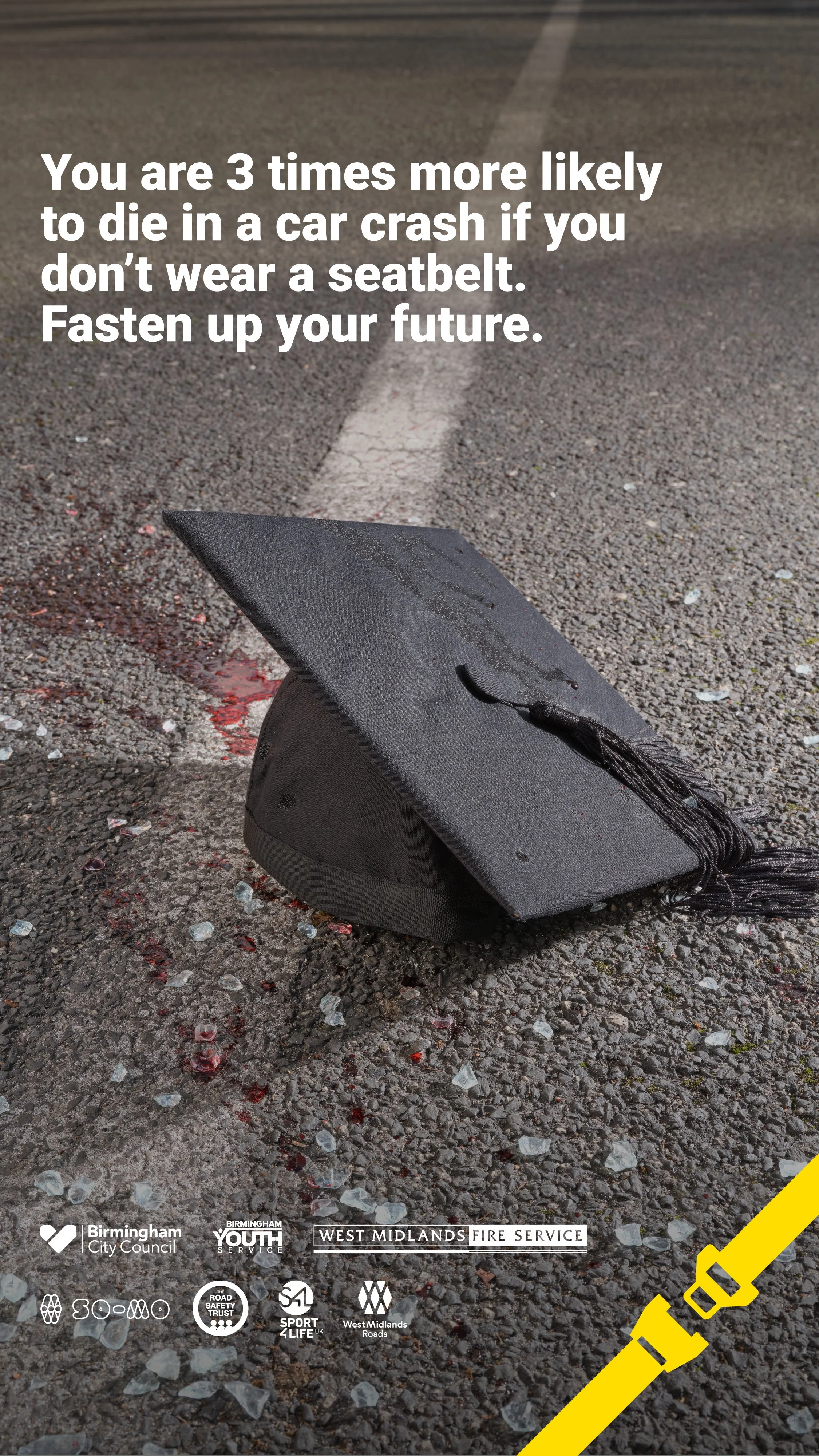Intervention.
When you're aiming to enhance customer engagement, improve employee performance, or drive public health initiatives.
SoMoCo’s intervention design service exists to help you achieve meaningful, lasting behavioural change.
The following case study is a great example of this.
Case Study :
Fasten Up Your Future: Uncovering Hidden Causes to Boost Seatbelt Use Among South Asian Teenagers.
Transport for West Midlands with additional funding from the Road Safety Trust.
Summary
Faced with alarmingly high road casualty rates in East Birmingham, SoMoCo was determined to look beyond an assumption that local car racing culture was the root cause.
Analysis of the data, SoMoCo uncovered critical insight into the problem: as suspected, casualties attributed to car racing turned out to be incredibly rare, however passenger casualties were significantly overrepresented, suggesting that low seatbelt use might be at play.
To test this hypothesis, SoMoCo conducted an on-street observational study, which revealed a 38% seatbelt non-wearing rate—far above the national average of 5.6%. A behavioural audit of previous campaigns further highlighted that the failure to deliver culturally relevant messaging had resulted in low awareness of risk and minimal motivation to wear seatbelts.
With this crucial insight in hand, SoMoCo collaborated with South Asian teenagers to develop a behaviourally tailored digital campaign that resonated deeply with the target audience.
The result was a significant increase in seatbelt usage, with 82% of non-regular users reporting improved habits. Remarkably, 73% of viewers recalled the message 6 to 8 weeks later, defying typical memory models.
This project exemplifies SoMoCo’s unique ability to find the ‘hidden factors’ and uncover critical insights needed to drive meaningful behavioural change, earning them national recognition for innovation in road safety.
Context
SoMoCo were tasked with addressing high road casualty rates in East Birmingham, a region with a predominantly South Asian population.
Initially our client attributed these rates to a local culture of car racing.
Deeper analysis was needed to uncover the true cause and devise an effective intervention.
Behavioural Analysis
Our analysis revealed that high passenger casualty rates, particularly among 16–24-year-olds, were driving up the figures – conversely car racing incidents were rare and had negligible impact on casualty figures.
We hypothesised that low seatbelt use was at the heart of the problem.
On street observations confirmed this, revealing a 38% seatbelt non-wearing rate, significantly higher than the national average of 5.6%.
We suspected that this was due to prior seatbelt campaigns failing to reach and engage this segment of the UK population.
For over 20 years, UK seatbelt campaigns had relied on emotional content featuring mainly white British actors. While emotion is effective for prompting action, it must resonate with the audience. When viewers don't see their own lives reflected, their ability to empathise and recall the central message is diminished - a case of 'message not received.'
Strategy
We recruited an online ethnographic community of over 20 South Asian young people to help us understand non-wearing behaviours and attitudes. We then devised a set of behaviourally optimised campaign messages and concepts, empirically testing these in randomised trials involving over 400 young people (50% South Asian).
Our test messaging outperformed both national and regional seatbelt campaign messages on every behavioural measure. Interestingly all South Asian respondents registered three times the emotional response when viewing the tailored messaging and content demonstrating our diagnosis and approach was correct.
Implementation
Codesign sessions were then used to create 30-second videos, with powerful narratives. They reflected the lives and aspirations of South Asian teenagers and were styled to blend seamlessly with popular lifestyle content favoured by our target audience.
The videos were launched as part of a six-week social media campaign, which targeted content to all young people living in the west Midlands.
Effectiveness was evaluated through social media analytics and follow-up surveys.
Results & Impact :
Result
Fasten Up Your Future went viral with 723,505 views on TikTok alone.
Our targeting strategy worked. 72.5% of the target population (470,697 West Midlands young people) had the campaign shown on their feeds, multiple times. Social media analytics.
Impact
We didn’t just reach a large audience; we reached those who needed it most. Half of viewers surveyed admitted to regularly neglecting seatbelt use. Of these:
82% of non-wearers reported increased seatbelt use after watching the campaign. Post campaign survey.
Impact
While accepted memory models show rapid forgetting of new information, behaviour change requires viewers to retain key messages and remain motivated long after viewing.
73% of viewers surveyed accurately remembered the video storylines and key message 6-8 weeks later. This was a remarkable result. Post campaign survey.
Reception
SoMoCo’s innovative Fasten Up Your Future Campaign garnered widespread recognition, leading to invitations to present at 11 conferences across the UK and Europe, as well as multiple industry accolades.
Highly Commended: CIHT Research Initiative of the Year 2022
Commended: CIHT Road Safety Award 2023
Winner: CiTTi Road Safety Award 2024
Legacy
Transport for West Midlands (TfWM) applied insights from this campaign to revolutionise how they engage communities in driving transformational change.
SoMoCo is in discussion with the Road Safety Trust to expand the "Fasten Up Your Future" campaign to the whole of the UK.
Legacy
SoMoCo’s commitment to recognising and empowering young people involved has supported personal and professional growth. For some, this became a launchpad for further achievements, and prestigious accolades, including:
Winner: Aston Villa Foundation's "Community Champion of the Year 2024"
Shortlisted: Greater Birmingham Young Professional of the Year, Not-for-Profit Award
Finalist: Inspirational Youth Awards
Testimonial:
“The diagnostic process of fully understanding the 'what' and 'why' before engaging the target audience to determine the right solution should be best practice for all road safety practitioners.”
DARREN DIVAL, REGIONAL ROAD SAFETY MANAGER (TFWM)





